For many years there has been a rumbling question as to whether .gov and .edu links have a higher weighting in the search engines than normal ones. Search engines would first look at whether there is any correlation between these domain types and extra quality signals derived from such factors – so to find out whether that is likely, we researched this question.
In this article, we will study the ratio of the .gov and .edu referring domains to the total number of referring domains, and compute some statistical quantities and correlations. For the purposes of this study, we will consider the percentage ratios for the whole of the Majestic Million data, and compare them to the first 100000, the middle 100000 and the last 100000 domains to see whether there are significant variations between the regions.
Figure 1 displays the boxplots for the distributions of the .edu and .gov referring domains over the whole list, as well as for that of the precentage ratios of each of these two types of referring domains. Note that the mean values (shown in blue) deviates sharply from the median values, indicating a very skewed distribution.
Figure 1: Boxplots showing the distributions of the .edu and .gov referring domains for all Majestic Million domains
Figure 2 shows the histograms for the .edu and .gov percentage ratios and correlation matrix for the various parameters for the whole list of Majestic Million domains. Figures 3, 4 and 5 display the histograms and correlation matrices for the first 100000, the middle 100000 and the last 100000 domains respectively.
|
Rank |
PercentageEDU |
PercentageGOV |
Citation Flow |
Trust Flow |
|
| Rank | 1 | ||||
| PercentageEDU | -0.005543335 | 1 | |||
| PercentageGOV | -0.013834575 | 0.109239025 | 1 | ||
| Citation Flow | -0.316571488 | -0.024398521 | 0.021802982 | 1 | |
| Trust Flow | -0.164331374 | 0.132980104 | 0.044435844 | 0.505039829 | 1 |
Figure 2: Histograms and Correlation Matrix for all Domains in the Majestic Million
The matrix above shows very little correlation between any of the variables considered, namely, the rank, percentage ratios of .edu and .gov domains and the Citation and Trust Flows. Both histograms show a large skewness to the right. For the .edu domains, 99% of ratios lie within 6.5, while in the case of the .gov domains, the corresponding figure is 4.0.
|
Rank |
PercentageEDU |
PercentageGOV |
Citation Flow |
Trust Flow |
|
| Rank | 1 | ||||
| PercentageEDU | -0.038978832 | 1 | |||
| PercentageGOV | 0.020002248 | 0.085794534 | 1 | ||
| Citation Flow | -0.273833324 | 0.006741905 | 0.040214216 | 1 | |
| Trust Flow | -0.272949446 | 0.181659647 | 0.079055862 | 0.578568012 | 1 |
Figure 3: Histograms and Correlation Matrix for the first 100000 Domains in the Majestic Million
|
Rank |
PercentageEDU | PercentageGOV | Citation Flow |
Trust Flow |
|
| Rank | 1 | ||||
| PercentageEDU | 0.00534977 | 1 | |||
| PercentageGOV | -0.013360862 | 0.053849779 | 1 | ||
| Citation Flow | -0.022008701 | -0.021609601 | 0.042411946 | 1 | |
| Trust Flow | 0.014417583 | 0.114120673 | -0.000390332 | 0.501982107 | 1 |
Figure 4: Histograms and Correlation Matrix for the middle 100000 Domains in the Majestic Million
|
Rank |
PercentageEDU |
PercentageGOV |
Citation Flow |
Trust Flow |
|
| Rank | 1 | ||||
| PercentageEDU | -0.009285506 | 1 | |||
| PercentageGOV | -0.007800166 | 0.130849686 | 1 | ||
| Citation Flow | -0.014315532 | -0.012822369 | 0.013030809 | 1 | |
| Trust Flow | -0.009675849 | 0.092266317 | 0.047516159 | 0.494459917 | 1 |
Figure 5: Histograms and Correlation Matrix for the last 100000 Domains in the Majestic Million
The situation is similar across all the other regions, with correlations between the variables being very low, and with all histograms heavily skewed to the right. The 99% values for the .edu domain ratios are 5.9, 7.0 and 7.2 respectively for the first, middle and last 100000 domains, while the corresponding figures for the .gov domains are 3.3, 11.0 and 3.6.
A consistent picture emerges in the case of the mean values of the Majestic SEO Citation and Trust Flow values across all the ranges, as shown in Figure 6, with the mean Citation Flow being always greater than the mean Trust Flow.
Figure 6: Mean Citation and Trust Flows across all ranges
A similar representation is also displayed in the case of the mean values of the percentage ratios, with the proportion of the .edu percentage ratio of referring domains being higher than the .gov values across all ranges, as shown in Figure 7.
Figure 7: Mean .gov and .edu Percentage Ratio of Referring Domains across all ranges
Conclusions
It would seem that search engines would be wise not to show EXTRA treatment for links just because they are on .edu or .gov sites and it would seem that any such impressions by SEOs are probably based on myth and legend than statistical theory. Most likely the myth arose because some search engines – Yahoo in particular – used to make it quite easy to search for links with a particular TLD such as .gov or .edu and this may have led SEOs into the mistake worse than the regular error of treating correlation as causation. I say worse, because there IS no obvious correlation, which suggests that SEOs relied on the only data they could glean from the search engines at the time, rather than gather enough data to make a statistical observation.
- Ranking of Top Data Scientists on Twitter using MajesticSEO’s Metrics - August 19, 2014
- Measuring Twitter Profile Quality - August 14, 2014
- PageRank, TrustFlow and the Search Universe - July 7, 2014







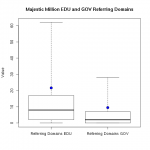
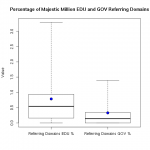

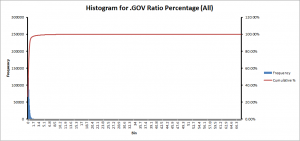
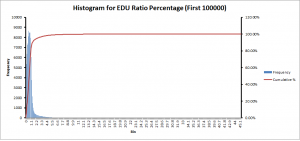

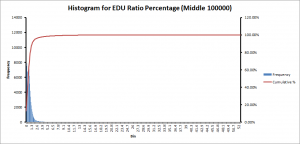
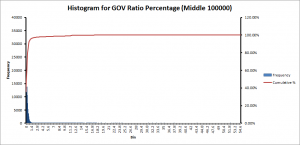
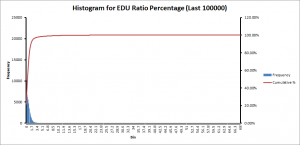
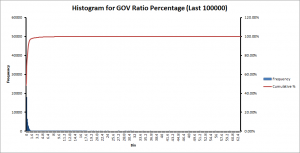
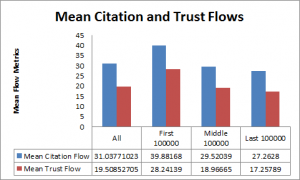
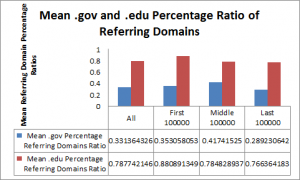
Very interesting stuff !
I take it that there is/was an increased benefit but due to the fact that .edu & .gov pages were usually on high/er authority domains so hence nothing to do with the fact they were .edu or .gov in themselves just that they tended to be higher authority domains and pages ?
@danlawrence
December 6, 2013 at 6:59 pmGreat and useful study as eradication of myths is a win win situation. I think you also have to consider that the trust search engines place on these different areas of these TLD’s likely varies also. Consider that most .edu have academic pages but also have far greater number of personal pages for students etc. IMO, **some** search engines can differentiate these …others…not so much. The students pages have been SEO targets…forever…to think SE’s didn’t know that is to have vastly under estimated their ability to manage the Social and Link graphs.
December 6, 2013 at 7:23 pmAwesome post. Very helpful to the webmasters. Given Clear idea about having .edu, .gov backlinks to a site.
December 7, 2013 at 6:36 amI’m glad you’ve taken the trouble to actually measure this – we can all save a lot of time by focusing on getting decent quality pr back links rather than harassing university lecturers or government departments that no doubt have more important work to do!
December 17, 2013 at 9:55 pmVery impressive research with an outcome thats even more interesting.
January 9, 2014 at 4:44 amI think The myth comes from the fact that, particularly .gov links were always inherently quite powerful due to the links they themselves had and the relationships they held.
January 29, 2014 at 5:59 pm